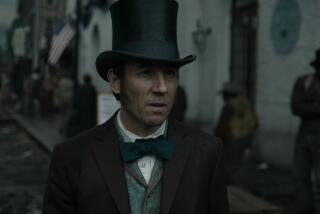The myth of ‘Rivals’
- Share via
People love Doris Kearns Goodwin’s book on the Lincoln presidency, “Team of Rivals.” More important, for this moment in American history, Barack Obama loves it. The book is certainly fun to read, but its claim that Abraham Lincoln revealed his “political genius” through the management of his wartime Cabinet deserves a harder look, especially now that it seems to be offering a template for the new administration.
“Lincoln basically pulled in all the people who had been running against him into his Cabinet,” is the way Obama has summarized Goodwin’s thesis, adding, “Whatever personal feelings there were, the issue was how can we get this country through this time of crisis.”
That’s true enough, but the problem is, it didn’t work that well for Lincoln. There were painful trade-offs with the “team of rivals” approach that are never fully addressed in the book, or by others that offer happy-sounding descriptions of the Lincoln presidency.
Lincoln’s decision to embrace former rivals, for instance, inevitably meant ignoring old friends -- a development they took badly. “We made Abe and, by God, we can unmake him,” complained Chicago Tribune Managing Editor Joseph Medill in 1861. Especially during 1861 and 1862, the first two years of Lincoln’s initially troubled administration, friends growled over his ingratitude as former rivals continued to play out their old political feuds.
In fairness, Goodwin describes several of these more difficult moments, such as when Secretary of State William Seward tried to seize political command from Lincoln during the Ft. Sumter crisis. But she passes over their consequences too easily.
Though Seward, the former New York senator who had been the Republican front-runner, eventually proved helpful to the president, the impact of repeated disloyalty and unnecessary backroom drama from him and several other Cabinet officers was a significant factor in the early failures of the Union war effort.
By December 1862, there was a full-blown Cabinet crisis.
“We are now on the brink of destruction,” Lincoln confided to a close friend after being deluged with congressional criticism and confronted by resignations from both Seward and Treasury Secretary Salmon P. Chase. Goodwin suggests that Lincoln’s quiet confidence and impressive emotional intelligence enabled him to survive and ultimately forge an effective team out of his former rivals, but that’s more wishful thinking than serious analysis.
Consider this inconvenient truth: Out of the four leading vote-getters for the 1860 Republican presidential nomination whom Lincoln placed on his original team, three left during his first term -- one in disgrace, one in defiance and one in disgust.
Simon Cameron was the disgraced rival, Lincoln’s failed first secretary of War. Goodwin essentially erased him from her group biography, not mentioning him in the book’s first 200 pages, even though he placed third, after Seward and Lincoln, on the first Republican presidential ballot. Cameron proved so corrupt and inept that the Republican-controlled House of Representatives censured him after he was removed from office in 1862.
Chase was the defiant rival. As Goodwin acknowledges, the Treasury chief never reconciled himself to Lincoln’s victory, continuously angling to replace him. Lincoln put up with this aggravation until he secured renomination and then dumped his brilliant but arrogant subordinate because, in his words, their “mutual embarrassment” was no longer sustainable.
Atty. Gen. Edward Bates was the disgusted rival. The elder statesman -- 67 when he was appointed -- never felt at home in the Lincoln Cabinet and played only a marginal role in shaping policy. He resigned late in the first term. His diary reflects deep discontent with what he considered the relentless political maneuvering of his Cabinet peers and even the president.
“Alas!” Bates wrote in August 1864, “that I should live to see such abject fear -- such small stolid indifference to duty -- such open contempt of Constitution and law -- and such profound ignorance of policy and prudence!”
Only Seward endured throughout the Civil War. He and Lincoln did become friends, and he provided some valuable political advice, but the significance of his contributions as Lincoln’s secretary of State have been challenged by many historians, and his repeated fights with other party leaders were always distracting.
John Hay, one of Lincoln’s closest aides, noted in his diary that by the summer of 1863, the president had essentially learned to rule his Cabinet with “tyrannous authority,” observing that the “most important things he decides & there is no cavil.”
Over the years, it has become easy to forget that hard edge and the once bad times that nearly destroyed a president. Lincoln’s Cabinet was no team. His rivals proved to be uneven as subordinates. Some were capable despite their personal disloyalty, yet others were simply disastrous.
Lincoln was a political genius, but his model for Cabinet-building should stand more as a cautionary tale than as a leadership manual.
More to Read
Sign up for our Book Club newsletter
Get the latest news, events and more from the Los Angeles Times Book Club, and help us get L.A. reading and talking.
You may occasionally receive promotional content from the Los Angeles Times.







